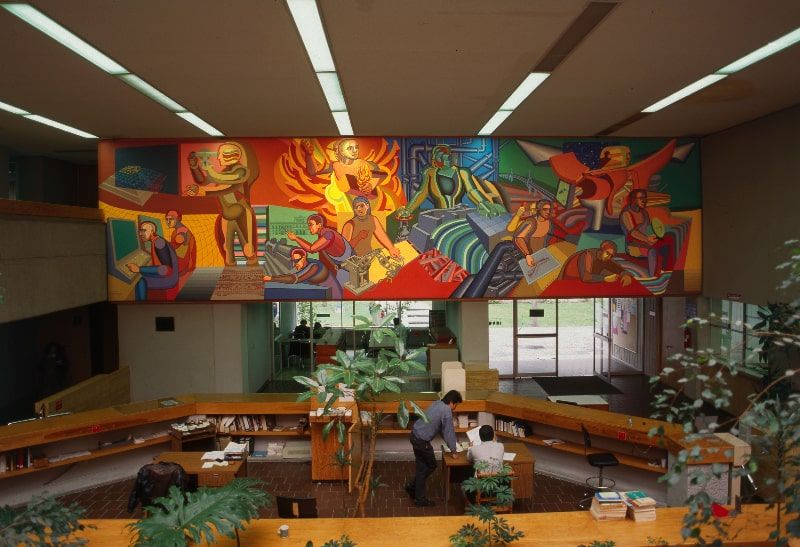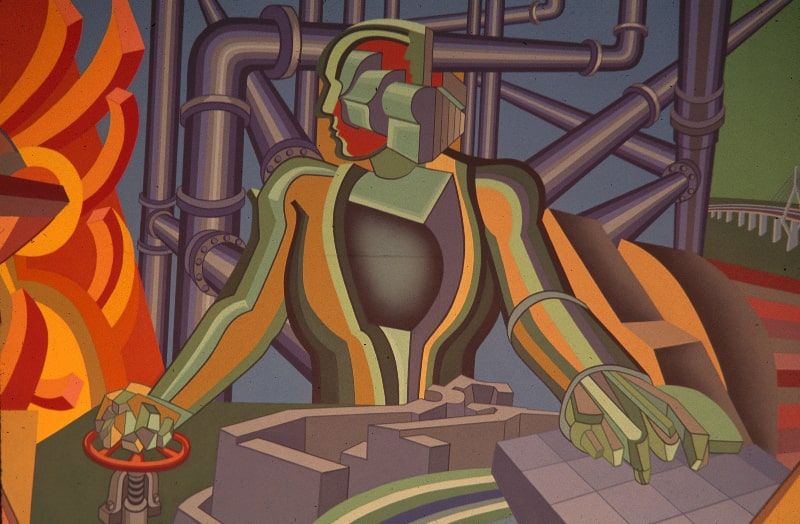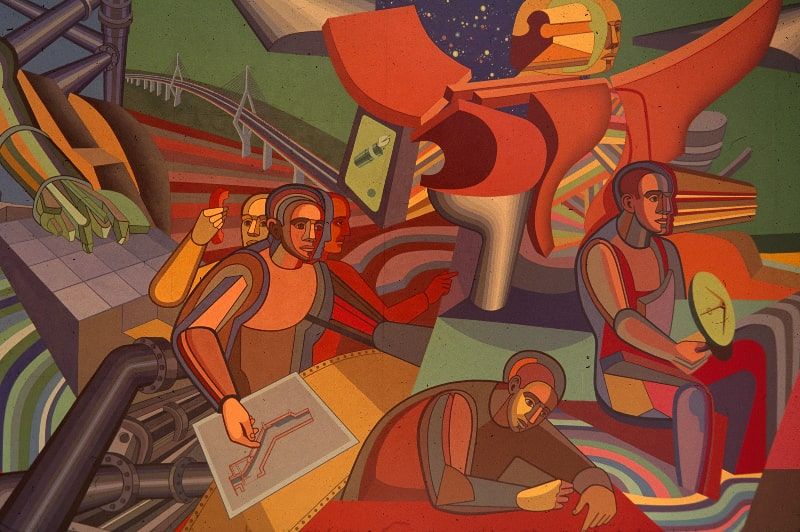Mural "Inventing the future" by Arnold Belkin (Inventando el futuro)
The mural "Inventing the Future" by Arnold Belkin, of 42 square meters, corresponds to the last stage of the artist's production. It is so named because it shows the visionary capacity of engineering to improve living conditions.

In 1990, with the sponsorship of the Alumni Society of the National University's School of Engineering (particularly of the 1954 Generation), as well as the Association of University Mechanical and Electrical Engineers and the College of Civil Engineers of Mexico, AC, the Mexican artist of Canadian origin Arnold Belkin painted his mural Inventing the Future (Inventando el futuro) on one of the interior walls of the Enzo Levi Library, of the Graduate Studies Division of the aforementioned academic institution, in Ciudad Universitaria.
"Inventing the future corresponds to the last stage of Belkin's production, who died two years later in Mexico City and, if my memory serves me correctly, it is the second to last great mural of about 30 that he did," says Luis Vargas Santiago, from the Institute of Aesthetic Research. According to the specialist, the idea of the sponsors was to give his faculty a mural that would highlight the role that engineering has played in the history of mankind. "It is called Inventing the Future because it shows the visionary capacity of engineering to improve people's living conditions," he adds.

Inventing the future, by Arnold Belkin based on allegories
Elaborated based on allegories, this mural has two levels: one upper and one lower, in which four great moments of history are recorded, marked by figures representing the four elements of nature: earth, fire, water and air.
"First, as a representative of the earth, there is a surveyor seeing through his tool how roads can be traced; then, as a representative of fire, a Prometheus; next, as a representative of water, a kind of android opening, in front of some pipes, a valve of what looks like a hydraulic dam; and, finally, as a representative of air, a winged character connected to a series of satellite inventions," he points out.
A second level of information is associated with historical moments in which engineering has made a defining contribution to the advancement of humanity.
"This one shows the structure of the Pyramid of the Sun, in Teotihuacan, which reminds us of the importance of Engineering for Mesoamerican civilizations; a representation of the Mining Palace, which is where the first school of Engineering of the UNAM emerged, linked to the exploitation of mines; the Tampico Bridge, built-in 1988; and the projects of the Morelos satellites, which Mexico launched into space in 1985. Of course, each of these works and projects is related to the same elements: the Pyramid of the Sun, to the earth; the Mining Palace, to fire; the Tampico Bridge, to water; and the Morelos satellites, to air," Vargas Santiago points out.
A third level of information has to do with the human beings that make possible or, well, operate these technological inventions of Engineering.
"In this level, we observe two people using computers, another controlling an electrical circuit, another one teaching a lecture (about the work of the Faculty of Engineering), a woman (the only one) manipulating the controls of a crane, an individual in front of a map, another one with a telephone, another one operating a satellite on a monitor, a student taking classes and, finally, someone with an antenna. Undoubtedly, the element that most connects with the public is the student taking classes, since the mural is located in a library and this is visited, above all, by students... In short, the theme of this mural addresses the four elements of nature and the most notable advances in engineering in its mechanical, hydraulic, civil and electrical branches," says Vargas Santiago.

Mural "Inventando el futuro": Frozen surfaces
From his pedagogical practice in the Mural Improvement and Production Workshop, which he founded in the 1980s at the National School of Plastic Arts (ENAP) of the National University, today the Faculty of Arts and Design, Belkin became the last great innovator or, if you will, the re-founder of muralism (in the 1950s he had been an assistant to David Alfaro Siqueiros).
"At that time he began to think about how muralism could be rescued and reinvented when it was perhaps reaching its decline or was no longer an art with the necessary strength to represent the history and politics it had in the post-revolution period," says the university researcher.
In that workshop, where he became one of the most popular and charismatic teachers at ENAP, Belkin created a pedagogical method and a model for painting murals relatively quickly and at low cost.
One product of this model is Inventing the Future. The plastic artist, born in Calgary, Canada, in 1930, completed it in only six months, with the collaboration of four of his students: Maribel Avilés, Leonora González, Susanne Junge, and Patricia Quijano, who later became his last partner and wife.

"In its elaboration, Belkin used synthetic resin paint, the famous polytech, which he applied with different techniques, but above all with an airbrush. That's why we see such icy surfaces... An interesting aspect of Inventing the Future is that it belongs to the stage when Belkin began to be more optimistic about what science, technology and culture could do for humanity. It is a mural that reflects much more intense, cheerful colors. In addition, it is striking that he did it in a public university, where the renovation projects in terms of infrastructure and technology for the country are being built. I think that's what Belkin's bet was going for," says Vargas Santiago.
Painted on a false cedar plywood wall, covered with acrylic sealant, and mounted on a wooden frame, this 42-square-meter mural was inaugurated on September 14, 1990, in the presence of José Sarukhán Kermez, then rector of the National Autonomous University of Mexico.




